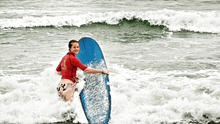Rash guard
A rash guard, also known as rash vest or rashie, is an athletic shirt made of spandex and nylon or polyester. The name rash guard reflects the fact that the shirt protects the wearer against rashes caused by abrasion, or by sunburn from extended exposure to the sun. These shirts can be worn by themselves, or under a wetsuit. A rash guard by itself is used for light coverage in warm to extreme summer temperatures for several watersports including surfing, canoe polo, water survival training, scuba diving, snorkeling, freediving, wakeboarding, bodysurfing, bodyboarding, windsurfing, kitesurfing, kayaking, stand up paddle surfing, or swimming. There are also lower body rash guards, which are similar to compression shorts to be worn under the surfers' boardshorts, but more specialized for surfers.

Rash guards are most often worn in surfing when the weather is too warm for a wetsuit, and to prevent wax-based chafing from sliding on and off of the surf board, on either the torso, or the legs. A surfboard's wax holds sand from the beach that could rub against a surfer's torso while paddling out to the break, or legs while sitting atop one's board. Rash guards also offer some protection from the sun (measured by its Ultraviolet Protection Factor) and slight protection against jelly fish stings and are sometimes worn under wetsuits to prevent chafing. A rash guard helps to prevent irritation caused by rapid impact with surface water and waves as well.
Rash guards are thought to have originated in Australia,[1] where they are commonly referred to as "rashies" or "rashys". Variations of the rash guard have made their way into other sports including baseball, American football, water polo, Grappling, Brazilian jiu-jitsu, and mixed martial arts. Athletes who wear rash guards in MMA/Grappling/BJJ seek protection against cuts, mat burns, and the spread of diseases.
Other important components of a rash guard include flatlock stitching, and six panel construction. Flatlock stitching creates a seam where the seam allowances lies flat to the garment instead of hanging loose from it. It is made by adjusting the overlock or the thread overedge stitch. Flatlock stitching increases the strength of the garment for intense exercise or recreational activities. Six panel construction and different material for separate body parts sewn together in panels allow the user increased mobility wet or dry versus the conventional four-panel tee shirt construction.
The combination of products used to construct a rash guard differ slightly depending on the designer. The use of nylon and spandex create a garment that is lightweight, quick drying, flexible, durable, naturally antibacterial and water wicking.
Variations
Some variations include the following:
- Cropped rash guard: A rash guard that is similar to a crop top and is made specifically for females. It can be paired with swimwear bottoms.
- Rash guard overall/bodysuit: A hybrid one-piece swimsuit (with boyleg/short or classic bottoms) with rash guard material and design. There are designs for males and females and this variation is much catered to children.
Swim shirts

Swim shirts are relatively new to the consumer market, but are growing in popularity. They are generally more loose fitting[2] and casually worn. Their primary purpose is to offer an alternative to sunscreen to protect the wearer's skin from the sun's UV radiation and possible skin cancer. Many swim shirts carry a UPF rating of 50+, which blocks out over 98% of the sun's harmful rays. Many people find that sunscreen isn't always enough because it is often not used properly and some have skin allergies or sensitivities to chemicals in sunscreens. Children's skin can be especially sensitive to the sun and sunscreens. Many children, and parents, find it is much easier to put on a swim shirt as it is loose and easily slipped on. There are also zip front rash guards available which makes slipping in and out of them even easier, especially when wet.[3] Furthermore, it is comfortable and yet gives sun protection.[4] Even though the name generally applies to water sports, people use swim shirts for an array of activities: swimming, boating, golfing, tennis, gardening, playing in the sprinklers, water parks, beach trips, pool play, rivers and lakes, water skiing, surfing, snow skiing, sledding, skimboarding, in mixed martial arts and Brazilian jiu-jitsu, and even as normal everyday clothing.
Rash guards for Grappling / MMA
Rash guards are also worn for training in various grappling sports and mixed martial arts (MMA). The benefits for this include:
- Protect skin against mat burn.
- Moisture control.
- Compression effect on the muscles which is beneficial when it comes to preventing muscle sprain/strain.
- Good hygiene practice.
See also
References
| Wikimedia Commons has media related to Rash guard. |
| Headwear | |||||||||
|---|---|---|---|---|---|---|---|---|---|
| Neckwear | |||||||||
| Tops | |||||||||
| Trousers | |||||||||
| Suits and uniforms | |||||||||
| Dresses and gowns |
| ||||||||
| Skirts | |||||||||
| Underwear and lingerie |
| ||||||||
| Coats and outerwear |
| ||||||||
| Nightwear | |||||||||
| Swimwear |
| ||||||||
| Footwear | |||||||||
| Accessories | |||||||||
| Dress codes |
| ||||||||
| Related | |||||||||